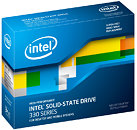Monday, April 16th 2012

Intel Announces Intel Solid-State Drive (SSD) 330 Series
Intel Corporation announced today the Intel Solid-State Drive 330 Series (Intel SSD 330 Series), a SATA 6 gigabit-per-second (Gb/s) solid-state drive (SSD) that gives consumers a more affordable entry into the accelerated storage performance of SSDs.
Ideal for upgrading desktop or notebook PCs, the Intel SSD 330 Series offers the price-conscious PC enthusiast a brand-name SSD that blends performance, Intel quality and value. Offered in the most popular capacity points, 60 gigabytes (GB), 120 GB and 180 GB, the Intel SSD 330 Series boosts overall system performance and responsiveness for a broad range of applications."An SSD is still the single best upgrade you can make to your existing PC, and the Intel SSD 330 Series gives users the latest Intel SSD technology at a price to meet their budget," said James Slattery, product line manager for client SSDs, Intel Non-Volatile Memory Solutions Group. "Backed by Intel's rigorous testing process, the Intel SSD 330 Series offers our users the speed they need at a great price, backed by world-class manufacturing, reliability and tech support."
Unlike a traditional hard disk drive (HDD) with spinning disks and moveable parts, SSDs offer a more rugged, low-power storage solution that dramatically improves system performance to keep up with today's I/O-intensive applications. The Intel SSD 330 Series contains Intel 25-nanometer (nm) multi-level cell (MLC) NAND memory. Its SATA 6 Gb/s interface doubles the bandwidth of its current SATA 3 Gb/s Intel SSD 320 Series, providing up to 500 megabytes-per-second (MB/s) sequential read speeds and up to 450 MB/s sequential write speeds for faster data transfers. Random read performance can go up to 22,500 Input-Output Operations Per Second (IOPS) and 33,000 write IOPS to boost overall application and system responsiveness, significantly outperforming a typical consumer hard disk drive.
Intel offers a broad range of SSD choices within four product families. The Intel SSD 300 Family is aimed at entry-level, mainstream client users. The Intel SSD 500 Family offers more fully featured, higher-performing client SSDs for computer and gaming enthusiasts. The Intel SSD 700 and Intel SSD 900 Families are targeted for data center applications.
The Intel SSD 330 Series comes in a standard 2.5-inch/9.5 mm form factor as a replacement to a slower-performing HDD. It can be used in a dual-drive desktop PC configuration to speed up boot times and applications speeds, or as a single-drive notebook upgrade.
Available beginning today at worldwide retailers and online e-tailers, the Intel SSD 330 Series is offered at the suggested channel price of $89 for a 60 GB drive, $149 for a 120 GB drive and $234 for a 180 GB drive. It is also backed by a 3-year limited warranty.
Ideal for upgrading desktop or notebook PCs, the Intel SSD 330 Series offers the price-conscious PC enthusiast a brand-name SSD that blends performance, Intel quality and value. Offered in the most popular capacity points, 60 gigabytes (GB), 120 GB and 180 GB, the Intel SSD 330 Series boosts overall system performance and responsiveness for a broad range of applications."An SSD is still the single best upgrade you can make to your existing PC, and the Intel SSD 330 Series gives users the latest Intel SSD technology at a price to meet their budget," said James Slattery, product line manager for client SSDs, Intel Non-Volatile Memory Solutions Group. "Backed by Intel's rigorous testing process, the Intel SSD 330 Series offers our users the speed they need at a great price, backed by world-class manufacturing, reliability and tech support."
Unlike a traditional hard disk drive (HDD) with spinning disks and moveable parts, SSDs offer a more rugged, low-power storage solution that dramatically improves system performance to keep up with today's I/O-intensive applications. The Intel SSD 330 Series contains Intel 25-nanometer (nm) multi-level cell (MLC) NAND memory. Its SATA 6 Gb/s interface doubles the bandwidth of its current SATA 3 Gb/s Intel SSD 320 Series, providing up to 500 megabytes-per-second (MB/s) sequential read speeds and up to 450 MB/s sequential write speeds for faster data transfers. Random read performance can go up to 22,500 Input-Output Operations Per Second (IOPS) and 33,000 write IOPS to boost overall application and system responsiveness, significantly outperforming a typical consumer hard disk drive.
Intel offers a broad range of SSD choices within four product families. The Intel SSD 300 Family is aimed at entry-level, mainstream client users. The Intel SSD 500 Family offers more fully featured, higher-performing client SSDs for computer and gaming enthusiasts. The Intel SSD 700 and Intel SSD 900 Families are targeted for data center applications.
The Intel SSD 330 Series comes in a standard 2.5-inch/9.5 mm form factor as a replacement to a slower-performing HDD. It can be used in a dual-drive desktop PC configuration to speed up boot times and applications speeds, or as a single-drive notebook upgrade.
Available beginning today at worldwide retailers and online e-tailers, the Intel SSD 330 Series is offered at the suggested channel price of $89 for a 60 GB drive, $149 for a 120 GB drive and $234 for a 180 GB drive. It is also backed by a 3-year limited warranty.


15 Comments on Intel Announces Intel Solid-State Drive (SSD) 330 Series
I’d like to have an Intel SSD and these are more affordable in terms of being Intel SSD models. Still I could buy a Corsair Force Series 3 240GB SSD or a Mushkin Chronos Deluxe 240GB SSD for the price of the Intel 330 series 180GB SSD. That is to say about ~$238 USD.
Intel would almost certainly be more reliable though,…
Benchmarking strategies differ so much - the same happens with Intel's other drives, but when they are benchmarked in the real world, they perform just like the other SSDs that have double the IOPS.
For SSDs to be even considered to be becoming mainstream, they would at maximum have to be only twice as expensive, and offering identical, or very similar capacity. :rolleyes:
But I dont think we will see a viable, cheap gaming SSD that is competitive with the speed of the smaller business and laptop designed SSD models for a while.
Mundo does what he pleases
According to the Anandtech artical, the Intel 520 went through ~1.5 years of development, certification and testing before they would sign off on a Sandforce controller based SSD. Compared to OCZ and others Intel really took their time with it. Other companies basically just pushed their Sandforce products out the door.